Making your dynamic messaging the most customer-centric starts by leveraging data for personalization.
As an eCommerce merchandiser, you’re experimenting with different badging tools on-site. You’ve tried different personalization solutions across your customer journey.
Like many of your competitors, however, you’ve come to the conclusion that these solutions just aren’t smart enough. Your product pages don’t offer the personalization your customers expect.
Your badging solution doesn’t offer the complexity to ensure certain products only bear specific messages, and even if this is possible, it’s highly manual and resource-heavy.
On top of this, you aren’t able to measure the performance of your badges in a way that you can derive actionable insights.
But the worst part of it all? The messages you’re showing aren’t resonating with your shoppers.
Poorly executed personalization will result in something seemingly minor like an increased bounce rate to something high-impact like customer dissatisfaction: Both things you want to decrease by adopting personalization in the first place!
72% of consumers will only engage with messages specifically tailored to their interests, and 74% will become frustrated if your webshop content isn’t personalized.
So what do you do?
To make your personalization the most customer-centric and actionable as possible you have to start small. Dynamic Messages are the small changes to your website that will make a big difference.
These messages are dynamic meaning they use AI to optimize in real-time. They leverage psychology and data to make the most out of personalization by:
- Relieving your webshop bottlenecks at multiple touchpoints in the buyer’s journey.
- Making your communication more tailored to the individual shopper.
- Ensuring frictionless customer experiences.
- Creating actionable insights from your webshop data.
What is Dynamic Messaging?
Dynamic Messaging leverages personalization to send the right message at the right time to your shoppers.
In other words, Dynamic Messages act as triggers that drive purchase behavior with visual cues that give customers more information about products, stock, or are persuasive messages designed to influence their choices.
Dynamic Messages are built based on theories originally found in psychology and behavioral economics. When done well, they not only increase metrics like CTR and CR, but they make the customer journey seamless by assisting in the decision-making process of your customers.
Why is Dynamic Messaging important for eCommerce personalization?
1. Reduces choice overload
Dynamic Messages are designed to reduce choice overload. Choice overload occurs when an individual is confronted with too many options, causing decision stress and anxiety.
In order to reduce choice overload, your Dynamic Messages should provide relevant information most likely to drive click-behavior. You can set up complex business rules to ensure messages only show up on specific products.
This means drawing attention to products that matter, and leveraging copy that resonates consistently across all your eCommerce pages.
2. Shows the right product at the right time
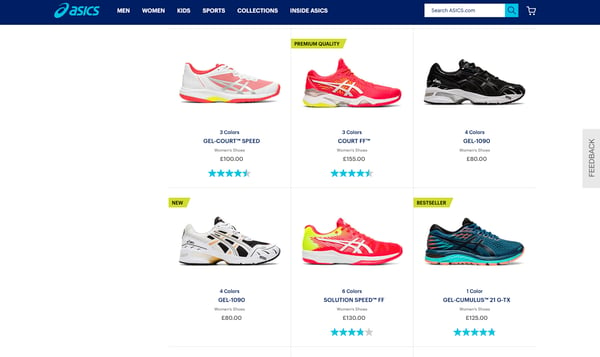
ASICS PLP with Crobox Dynamic Messaging. The products with badges as well as the messages on the badge are selected based on our predictive algorithm. Read more about the Crobox AI.
Dynamic Messages are an easy step to creating more strategic messaging across multiple touchpoints.
It isn't just about putting badges on random products. Instead, Dynamic Messaging uses “recommendation algorithms” to select the product(s) the specific shopper is most likely to be interested in.
On top of that, it selects the message in the same way. These predictions are all based on the in-session behavioral data of the shopper (more on that below).
In line with behavioral nudge theory and Fogg’s Behavioral Model (i.e., FBM, see graph below), Dynamic Messages have specific timing, placement, and copy to ensure they succeed at driving purchase behavior.
Dynamic Messages should be placed within the optimal prompt point.
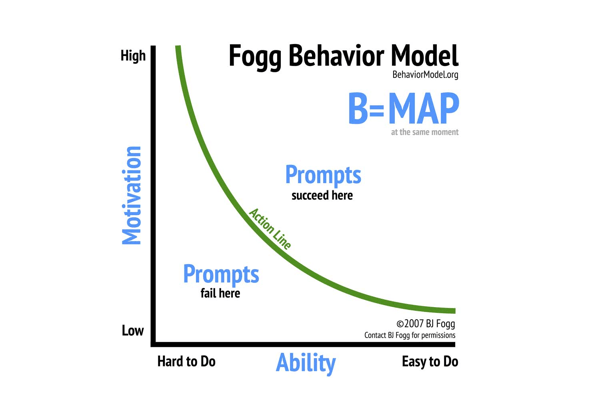
Source: Behavior Model
Meaning, if an individual is motivated and able to carry out a task, there should also be a trigger to help them complete said task. Your Dynamic Messages are these triggers. They act as prompts to help your shoppers complete their shopping goals.
To learn more about leveraging the FBM to drive purchase behavior in eCommerce, read this article.
3. Personalizes the customer journey
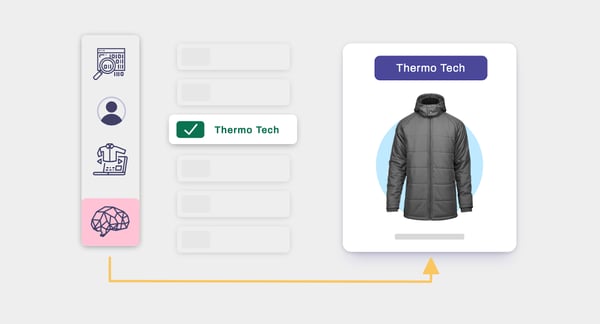
On the whole, Dynamic Messages are important for personalizing the customer journey. They are ‘dynamic’ because they auto optimize based on the contextual data of the user.
This means they continuously optimize based on the shopper’s in-session behavioral data (allowing retailers to stay within data-protection laws).
For example, these are contextual clues are used to train the machine learning algorithms:
- What product badge drove the customer to click on a product?
- What product notification increased add-to-cart clicks?
- What other products has this user viewed?
- What filters did they use?
- How did they navigate your product taxonomy?
At Crobox, our AI tracks this behavioral data and uses the information to show messages most likely to resonate with the individual. It learns from the shopper’s context and then shows them the best message based on this.
For more about how the Crobox AI works, read this post.
Or check out our brand video!
Types of Dynamic Messages
There are multiple types of Dynamic Messages you can use across the customer journey. From your PLP to PDP to checkout, here are some examples.
1. Dynamic Badges on the PLP
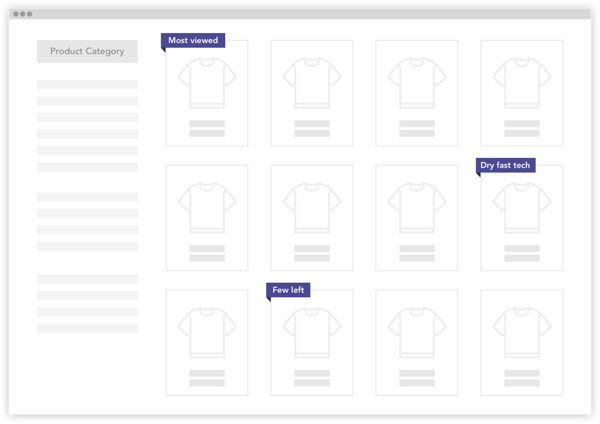
Dynamic Badges increase click-through rates on the PLP reduce choice overload by highlighting what’s special about different products.
These product badges can be behavioral nudges or product attributes:
- Behavioral nudges are based on behavioral principles, showing the benefits of a product like “Most Viewed” (leveraging Social Proof) or “Few Left” (leveraging Scarcity).
- Product attributes show the features of a product like “Dy fast tech”, “Reflective”, or “Thermal”.
By testing your product badges in terms of click-behavior, you can begin to see how people engage with your products.
Then, you can optimize your badges by choosing to show messages that will best fit what your customers are looking for in your products when they shop with you. Product badging brings the worlds of product and customer-centricity together.
2. Dynamic USPs on the PDP
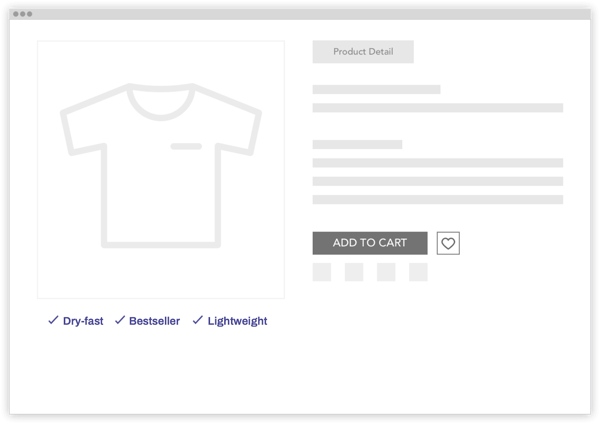
Dynamic USPs are similar to Dynamic Badges, as they highlight product attributes and behavioral nudges, except on the PDP. These messages are geared at increasing the add-to-cart rate.
When shoppers land on a PDP, they are generally looking for more product information. Dynamic USPs highlight the product’s features that are most likely to resonate with the individual in an easy to read, familiar format.
3. Dynamic Notifications on the PDP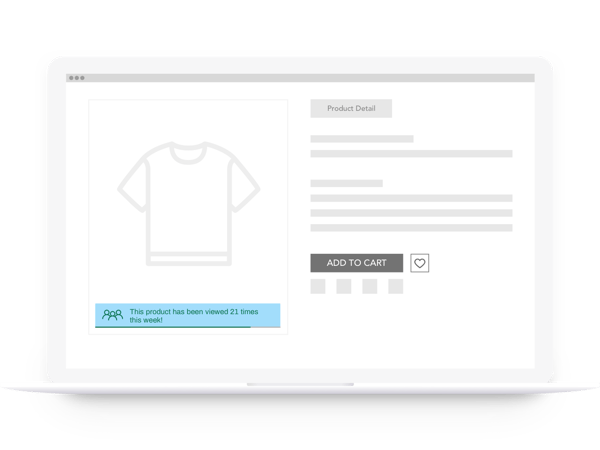
Dynamic Notifications are used to capture the attention of the shopper on the PLP and nudge purchase behavior.
These messages are generally derived from psychology, using principles like Social Proof or Scarcity to increase the desirability. Dynamic Notifications, when used well, can be big conversion boosters.
However, used poorly and they can interfere with the browsing experience. Notifications that aren’t personalized based on the individual user will be seen as annoying and intrusive.
It’s important you consider which part of the funnel your customers are in, and tailor your notifcations to be informative and dynamic.
4. Dynamic Checkout Boosters
Dynamic Checkout Boosters increase the checkout rate by highlighting messages that urge the shopper to continue through their purchase path.
This is the funnel stage where your shoppers are looking for trust, guarantees, and safety messages to get them to share private information in a frictionless way. A smart notification guaranteeing trust is a good message to show.
You can also leverage Goal Gradients, trust symbols, or provide options like free delivery, gift-wrapping, etc.
Dynamic Messaging reporting
The challenge that many merchandisers face when it comes to personalization is that many tools don’t provide performance data specific to the tactic used.
For example, badging solutions will only give the total conversion rate uplift, rather than breaking this down on a message level.
At Crobox, we believe knowing what works is just as valuable as knowing what doesn’t work. That’s why for each of our Dynamic Messages, we measure click-stream data (click-through rates and add-to-carts).
This allows us to provide actionable data on which messages drive the most impact for customer segments (and which don’t).

This gives you the data you need to understand which campaigns are performing strongest. It also sets you up to reuse this data throughout your website.
What’s more, Crobox provides performance data on a product level. Meaning you can get a detailed view of how your shoppers are engaging with your products and which messages are performing best.
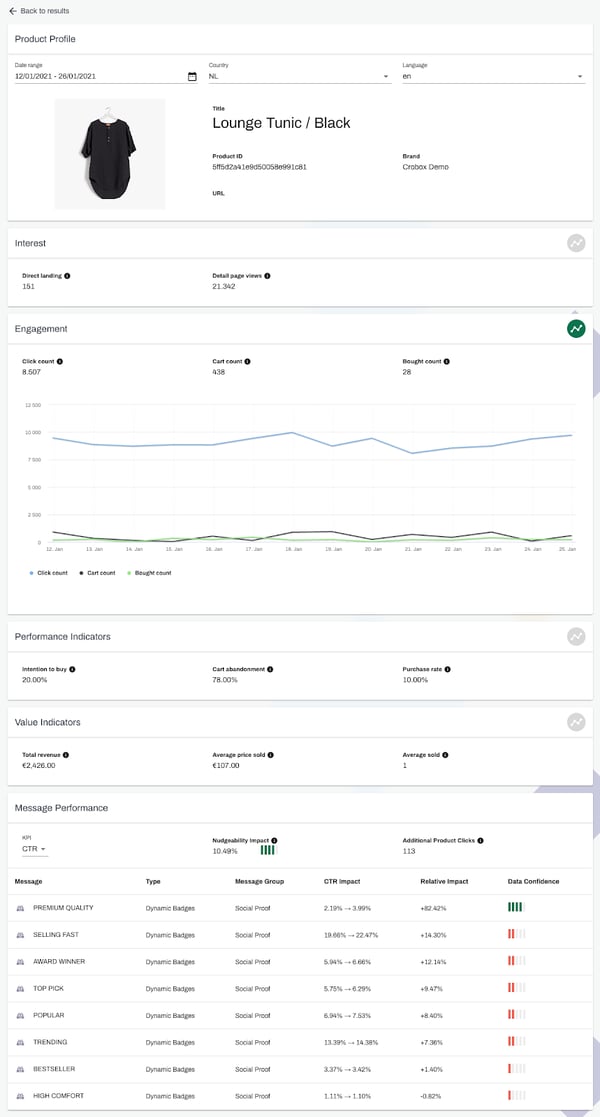
To learn more about the data shown in this screen, check out our knowledge base.
Wrap Up
Dynamic messaging is an important step to make your on-site personalization more intelligent. Your Dynamic Messages reduce choice overload and show the right product at the right time.
But while placing and promoting your messages across your webshop is great, true personalization lies making Dynamic Messaging data actionable. This is where merchandiser’s can take personalization to the next level.
Your Dynamic Messages generate data that can optimize your conversions and CX to make for very happy shoppers. It’s a great foundation to build data-driven strategies that will delight your customers across multiple channels.
